Greek mythology’s Titan Leader, Cronus

In Greek mythology, Cronus was the leader of the Titans and the father of Zeus.
As the most prominent among the Titans, Cronus played a central role in the epic narratives that shaped ancient Greek mythology with the rise of the Olympian gods. From his ascension to power to his eventual downfall at the hands of his son Zeus, the life of Cronus shows the complex dynamics of divine rulership and the inevitability of change. His story is one of immense power, dramatic conflict, and the cyclical nature of generations.
Cronus and the Major Titans in Greek Mythology
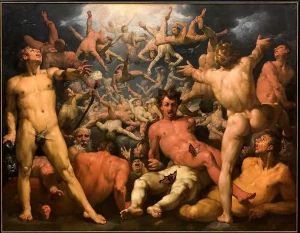
The Fall of the Titans, by Cornelisz Van Haarlem, 1588-90, via Statens Museum
The Titans, born from the union of Gaia (Earth) and Uranus (Sky), were a group of 12 deities known for their immense strength and divine powers. Their reign predated that of the Olympian gods and goddesses, whom they later clashed with in a battle known as the Titanomachy. The 12 Titans included six male and six female deities. The male Titans were the Cronus, Oceanus, Hyperion, Iapetus, Coeus, and Crius. While Rhea, Tethys, Theia, Phoebe, Themis, and Mnemosyne were the female ones. These titans held dominion over specific aspects of the cosmos and natural world, such as the seas, sky, and celestial bodies.
The youngest of Gaia and Uranus’ Titan children was Cronus. He was linked with the concept of time and the cyclical nature of life. Later, he became further associated with agriculture and was worshipped to ensure the fertility of the earth and plentiful harvest. Thus, he was often depicted holding a sickle or scythe, a weapon that had once helped him to gain power.
Cronus vs. Uranus
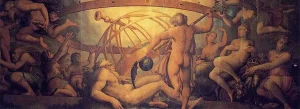
The Mutilation of Uranus by Saturn, by Giorgio Vasari and Cristoforo Gherardi, 16th Century, via Palazzo Vecchio
As the Titans grew in strength and numbers, Uranus began to fear his children’s power and saw them as a threat to his rule over the cosmos. Driven by his paranoia, he imprisoned his children within the Earth. Gaia decided to take matters into her own hands distraught over the fate of her children. She created a sickle made of adamant, an indestructible material, and sought the assistance of her Titan children in overthrowing their father. Cronus, the most ambitious of the Titans, stepped forward to fulfill his mother’s wishes. He confronted Uranus and castrated him, effectively dethroning him as the ruler of the cosmos. The blood that spilled from Uranus birthed the Giants, the Erinyes, and the Meliae. While his severed genitals were thrown into the sea by Cronus; the goddess of beauty and love, Aphrodite, was born from this flesh and sea foam.
Cronus Married His Sister Rhea
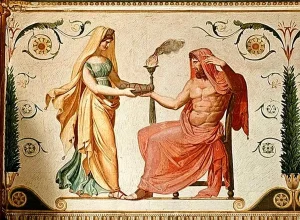
Cronus and Rhea, by Karl Friedrich Schinkel, 19th Century, via Wikimedia Commons
After taking the throne, Cronus assumed the role of the ruler of the cosmos and married his sister, Rhea. She was associated with motherhood, fertility, and nature. Surprisingly, it was her wrestling skills that played a crucial role in solidifying their rule over Mount Olympus, against two rival gods.
Ophion, a serpent-like god, was associated with his wisdom and the heavens. Eurynome was the daughter of the sea-god Oceanus. During the early days, they reigned as the rulers of Mount Olympus and were considered a threat to the Titan couple’s power. Cronus and Rhea thus confronted these rival deities, engaging in a struggle for control. Rhea specifically fought in an intense wrestling match with Eurynome, but it was the Titaness that emerged victorious. The defeated gods were cast into the ocean, while Cronus and Rhea ascended as the rulers of Mount Olympus.
The Golden Age of Cronus
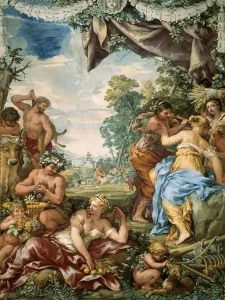
The Golden Age, by Pietro da Cortona, 17th century, via Wikimedia Commons
The Golden Age referred to a period of peace, prosperity, and happiness, throughout the reign of Cronus. During this time, the world was full of abundant resources enabling people to live in harmony without burdens. People were free from disease, old age, and war. The collective joy and prosperity experienced during this era formed the epitome of a utopia. Gods and humans alike were said to live in connection with one another, the divine and mortal realms entwined. This time was markedly different from the later Ages of Silver, Bronze, and Iron, which were plagued by increasing hardship and conflict.
Cronus Eats His Children
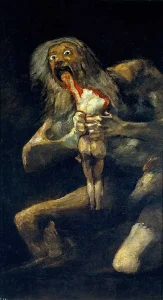
Saturn Devouring His Son, by Francisco de Goya, 1820-23, via Museo del Prado
Cronus and Rhea soon became the parents of the first generation of Olympian gods. Among their offspring were Hestia, the goddess of the hearth; Demeter, the deity of harvest; Hera, the goddess of marriage; Hades, the ruler of the dead; Poseidon, the god of the seas; and Zeus, the lightning-bear, and eventual king of the gods. Cronus, however, was haunted by the same fear that plagued his father. He became consumed by paranoia and a desire to maintain his power, for an oracle had prophesied that one of his own children would overthrow him just as he had dethroned Uranus.
Thus, as each of his children was born, Cronus immediately swallowed them whole, imprisoning them within his own body. However, when Rhea was pregnant with her sixth child, Zeus, she crafted a plan to save her youngest son and ensure his survival. When Zeus was born, Rhea presented Cronus with a stone wrapped in cloths, pretending it was their newborn child. Unaware of this, Cronus swallowed the stone, thinking it was the baby. The goddess sent the child into hiding on the island of Crete, where he would grow up to devise a plan to defeat his father. This led to the Titanomachy, a colossal war between the Titans and the Olympians, in which Zeus and his siblings fought to free themselves from their father’s tyranny.
Cronus vs. Zeus: The Titanomachy
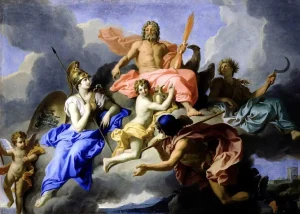
Minerva and the Triumph of Jupiter, by Rene-Antoine Houasse, 1706, via Wikimedia Commons
The first step of Zeus’ plan was to gain his father’s trust. He assumed the role of Cronus’ cupbearer, offering him a tainted drink. The potion caused the Titan’s stomach to convulse, forcing him to throw up his swallowed offspring. Each of Zeus’ siblings emerged from their father one by one, freed from their captivity. The rise of this new divine generation marked the beginning to the end of Cronus’ reign. The lightning god realized, however, that he needed the help of other formidable allies to conquer the Titans.
He descended to the depths of Tartarus to request the help of Cronus’ other siblings, the Cyclopes and Hecatoncheires. The one-eyed Cyclopes were renowned for their craftsmanship and immense strength, while the formidable Hecatoncheires possessed a hundred arms each. These beings had been imprisoned by Cronus for the power they possessed. With the promise of their freedom, they joined the forces of the gods.
As a display of their gratitude, the Cyclopes presented the legendary thunderbolts to Zeus, the trident to Poseidon, and the helmet of invisibility to Hades. On the opposing side, Cronus rallied together the Titans convincing them to join his effort for the sake of their dominions.
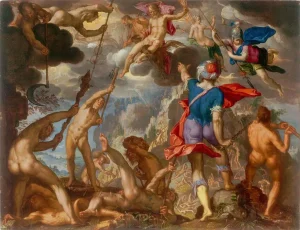
The Battle Between the Gods and the Titans, by Joachim Wtewael, 1600, via Art Institute of Chicago
The battle lasted for a monumental ten years. The clash of the divine forces shook the heavens and reverberated throughout the world. The skies were ablaze with lightning, the seas roared, and the foundations of the earth trembled. The gods, using their newly forged weapons, unleashed their godly might upon the Titans. Zeus hurled thunderbolts with devastating force, Poseidon summoned tidal waves and earthquakes, and Hades wielded the power of the underworld, unleashing darkness and death.
The Titans fought back fiercely. Cronus, armed with a formidable scythe, led the charge, displaying his raw strength. Oceanus unleashed the power of the seas, while Coeus devised intricate battle strategies. But it was the intervention of the Cyclopes and Hecatoncheires that tipped the balance of power in favor of the gods.
In a climactic moment, Zeus delivered a mighty blow that sent Cronus crashing to the ground. With Cronus defeated, the Titans were bound and imprisoned in Tartarus, the deepest abyss within the underworld. Tartarus served as an inescapable prison, ensuring the Titans would remain confined for eternity. The gods emerged as the new ruling deities of the cosmos. As the leader, Zeus established his dominion from Mount Olympus, while his siblings assumed their respective territories within the divine order.
Cronus, Philyra, & the Birth of Chiron
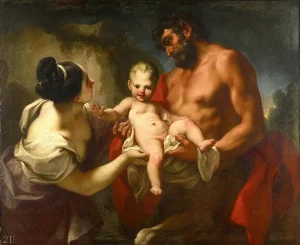
The Centaur Chiron Receiving the Infant Achilles, by Antonio Balestra, circa 1710-20, via Royal Collection Trust
During his exile in Tartarus, Cronus encountered Philyra, a nymph, and daughter of the Titans Oceanus and Tethys. Overcome by desire, he sought to pursue Philyra but remained cautious of suffering Rhea’s anger. Thus, Cronus transformed himself into a horse, concealing his identity. It was in this form that he approached Philyra, and a passionate encounter occurred.
The outcome of their union was the birth of an extraordinary being named Chiron. Possessing the lower body of a horse and the upper body of a human, their child was known as a mythical creature called a centaur. Philyra made the decision to entrust Chiron’s upbringing to the gods, Apollo and Artemis. Under their guidance, Chiron grew up to be a skilled healer, wise teacher, and mentor to numerous legendary heroes, including Achilles and Hercules.
Cronus: Worship & Legacy
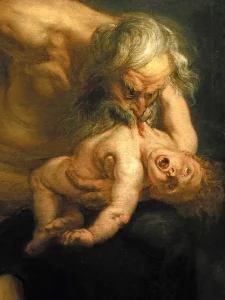
Saturn, by Peter Paul Rubens, 1636-8, via Museo Nacional Del Prado
In the ancient world, worshippers revered Cronus as a deity presiding over the realms of time, harvest, and agriculture. Devotees sought his favor through intricate rituals, grand offerings, and ceremonies held in temples and sanctuaries dedicated to his name. Farmers asked his blessings for fruitful harvests, offering sacrifices to the Titan.